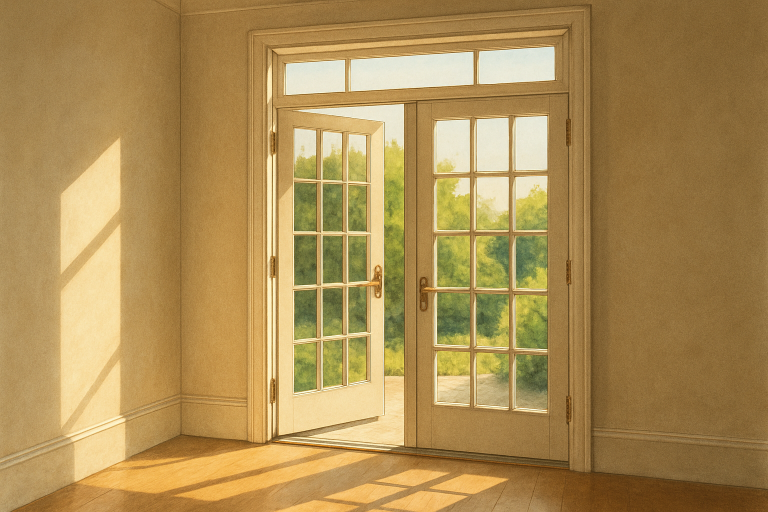Table of Contents
- 1 A Brief Look at Where French Doors Began
- 2 What Characterizes a French Door?
- 3 Natural Light and Openness: Design Advantages
- 4 Integrating French Doors Into Different Home Styles
- 5 Material Choices and Durability Considerations
- 6 French Doors and Energy Efficiency
- 7 Enduring Elegance and Practical Value
A Brief Look at Where French Doors Began
French doors date back to the Renaissance period, when symmetry, proportion, and natural light became central to architectural design. Inspired by Italian influences, French craftsmen created tall, windowed doors that opened outward, allowing sunlight to flood into interior spaces. These doors were functional and elegant, blending the idea of a window and passageway, quickly making them popular in homes, palaces, and gardens across Europe.
The fascination with French doors has endured for centuries, mainly because of their timeless aesthetic and practical design. People often wonder, why are French doors called French doors? The name stems from their development and widespread adoption in France during the 17th century. Today, their enduring style and adaptability continue to make them a sought-after design choice in traditional and modern architecture.
What Characterizes a French Door?
French doors are immediately recognizable for their narrow frames and extensive glass panels. They are usually fashioned as a matched pair that swings open from the center. The design often highlights divided lites: small, distinct panes joined by muntins for a classic, airy effect. This timeless profile does more than attract compliments—it invites natural light and blurs the boundary between spaces. Whether used to welcome guests through a garden entrance or divide rooms within a home, these doors promise beauty and seamless flow.
French doors’ popularity isn’t limited to architecture. They can serve as exterior entryways, elegant transitions to patios, or even internal dividers that maximize sunlight between living areas. Their adaptability and understated charm have cemented their position as a coveted design element, enabling homeowners to enhance openness, boost connectivity, and add intrinsic value to their properties.
Natural Light and Openness: Design Advantages
Bringing generous daylight into the heart of the home is a hallmark of French doors. These doors multiply sunlight, especially in rooms that struggle with shade or enclosed layouts, making spaces feel larger, more welcoming, and vibrant. In fact, integrating glass doors and windows is a proven way to drastically improve visual appeal and perceived square footage. This design move reduces the need for artificial lighting, supports well-being, and enhances the overall ambiance of interiors.

Integrating French Doors Into Different Home Styles
The adaptability of French doors allows them to complement everything from grand colonial homes to urban lofts. In traditional settings, the doors reinforce classical symmetry and connect interior rooms to sun-drenched verandas or formal gardens. Modern homes often embrace streamlined, grille-free French doors for minimalist appeal, blending indoor and outdoor environments for a seamless lifestyle experience. The choice of grille patterns, glass style, and frame finish makes it easy to personalize the look to suit any décor. Matching the style of your doors to your existing architecture ensures a harmonious, tailored result.
Material Choices and Durability Considerations
Selecting the right material plays a critical role in the performance and longevity of French doors. Wood remains a perennial favorite, beloved for its warmth and traditional charm. However, it demands periodic care—such as sealing or painting—to withstand weather and everyday use. Fiberglass and vinyl provide a low-maintenance alternative, resisting moisture and warping, and are well-suited for busy households or harsh climates. For a sleek, modern aesthetic, aluminum frames deliver excellent strength and lightness, although they might not insulate well in colder regions.
Beyond visual appeal and upkeep, the climate plays a major part in material choice. In coastal areas, homeowners often prefer materials that resist salt and humidity, while those in colder climates lean towards insulated frames and panes to maximize indoor comfort. Many newer French door installations feature advanced finishes and protective coatings, simplifying maintenance without sacrificing beauty.
French Doors and Energy Efficiency
The evolution of French doors goes beyond design trends—modern advances have prioritized energy efficiency. Many of today’s options feature double- or even triple-glazed glass, low-emissivity (Low-E) coatings, and weatherproofed frames. These upgrades prevent drafts, minimize heat transfer, and optimize comfort year-round. Investing in high-performing windows and doors can substantially reduce energy costs and environmental impact.
Consider certifications such as ENERGY STAR to ensure top-tier insulation and durability when shopping for new French doors or replacements. Properly installed, energy-efficient doors help stabilize indoor temperatures, protect furnishings from UV rays, and contribute to a greener, more cost-effective household.
Enduring Elegance and Practical Value
French doors remain a testament to design that balances beauty with function. From their Renaissance origins to today’s energy-efficient innovations, they continue to adapt to changing architectural styles and homeowner needs. By offering natural light, versatile style, and durable options, French doors enhance a home’s aesthetics and comfort. Their timeless appeal ensures they’ll remain a cherished choice for future generations.

